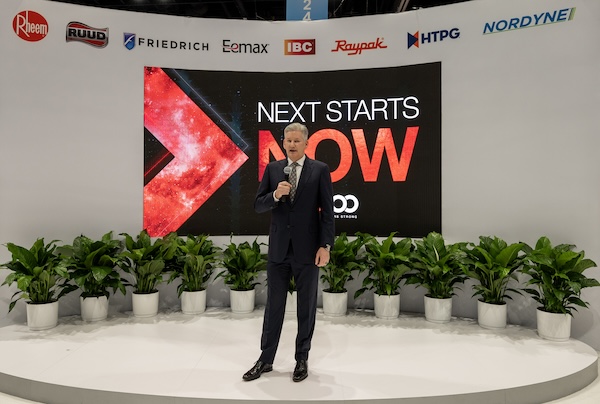Does the image have a perception problem?
heating and cooling

Table of Contents
On this Weekly Update, we talk about the plumbing industry’s image problem, Dunwoody giving back, and a cutaway tankless water heater, and our freshly baked podcasts.
Plumbing Perception
Does the industry have an image problem? Do we need to change the plumbing lexicon?
Dunwoody College
Dunwoody College of Technology recently completed the largest fundraising campaign in its history, raising $80 million to expand access to technical education and support student success in the skilled trades. For more, https://dunwoody.edu
Tankless Cutaway
Eric takes a look at the Adapt+ Premium Condensing Tankless Water Heater
Podcasts
AFC — Robert O’Brien, Director of Education, NORA
MTGA — Buying American Made?
Sign up for our newsletter: https://mechanical-hub.com/enewsletter/
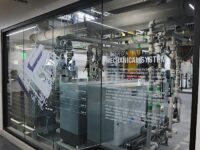
Weber State University Chooses All-Climate Heat Pumps to Help Meet Its HVAC Performance Goals
Table of Contents
Weber State University is creating an environmentally friendly, energy-conscious campus that simultaneously serves as a living laboratory for students in its engineering and environmental programs. The school’s environmental goals include electrification by eliminating conventional, natural gas-fired, and less efficient HVAC systems. So far, about half of the campus’ HVAC systems are fully electric.
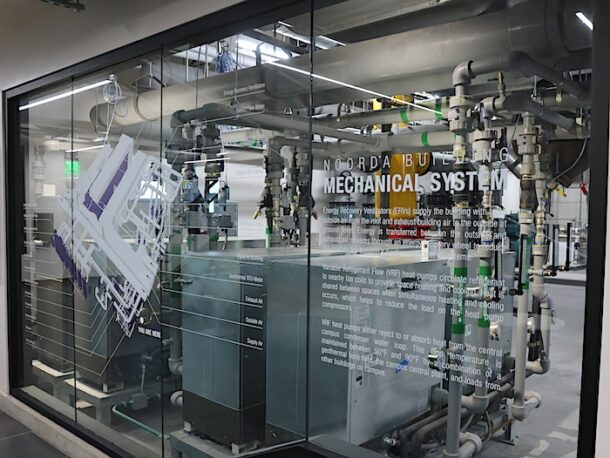
Historically, Weber State University’s buildings have been cooled with chilled water from a central water plant and heated with steam from a central steam plant, neither of which are energy-efficient compared to modern systems. Today, many of its buildings have been retrofitted with all-electric, all-climate, water-source heat pump solutions. Moving forward, the university plans to convert the entire campus to Mitsubishi Electric Hybrid Variable Refrigerant Flow (VRF) solutions. Hybrid VRF systems use water instead of refrigerant indoors and are a key technology in the movement to electrify and decarbonize buildings.
“We’re also creating an energy recovery network for our entire campus, with all buildings connected to the same water loop,” said Justin Owen, Interim Director of Operations for Weber State University.
“The Mitsubishi Electric heat pumps connected to that water loop enable us to save money on our electricity bills and reinvest those savings into renewable solutions like solar, which allows us to source that electricity renewably,” he said.
Learning About All-Climate Heat Pumps
In 2015, Weber State University started installing water-source VRF systems. For instance, the university has a ductless, water-source VRF heat pump system from Mitsubishi Electric in its Noorda Engineering building. The Noorda Engineering building is home to the university’s electrical engineering, mechanical engineering, and energy engineering programs. Most parts of the VRF solution are on display to students, labeled and exposed – from the condenser to the branch controller to the fan coils – enabling them to learn and work with all-climate heat pump technology.
University personnel attending a trade show in Las Vegas were introduced to the Mitsubishi Electric Hybrid VRF solution by their HVAC distributor, Applied Product Solutions, located in south Salt Lake City. In 2024, Weber State installed its first water-source, Hybrid VRF solution in its six-level SkySuites, an addition to Stewart Stadium. The SkySuites house the Weber State Athletics Department, coaching staff offices, a press box, 26 suites, 150 club seats, and a study area for student-athletes.
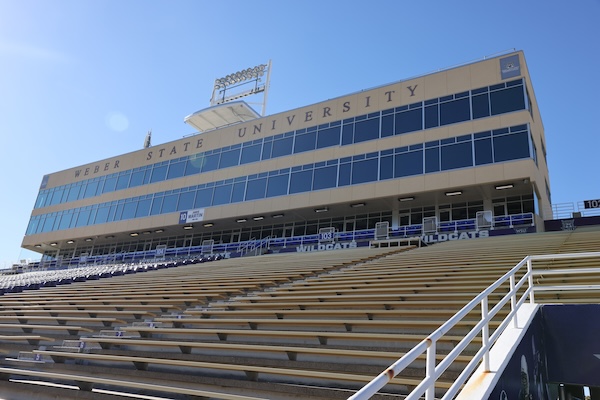
“One thing that I’ve been really impressed with regarding the Mitsubishi Electric hybrid system is that it uses less refrigerant than a more conventional system, which is really important to us, especially with the coming changes to new low GWP refrigerants,” said Brad Lash, P.E., Vice President, WHW Engineering.
Enjoying the Benefits of VRF and Hybrid VRF
An advantage of VRF and Hybrid VRF technology is improved comfort and efficiency provided by zoning. With zoning, each room has its own thermostat, giving occupants control to heat or cool their space to their comfort level.
“At our homecoming football game, I stopped by our presidential suite because historically, the SkySuites’ temperature was hard to manage, said Owen. “When I asked President Mortensen about the temperature, he said, ‘It’s been great. It’s normally hot in here, but I’m comfortable.'”
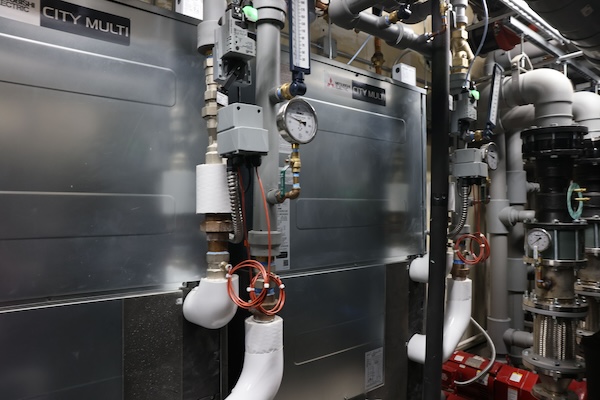
Weber State University also benefits from Mitsubishi Electric smart energy controllers that come with a light-level sensor and an occupancy sensor. These energy-saving features enable staff to remotely control temperatures and adjust thermostats in unoccupied rooms to save on energy bills.
“Mitsubishi Electric Hybrid VRF consumes a lot less energy than our conventional systems,” said Owen. “Whenever we do a retrofit, I run some energy numbers on what we consumed before and what we consume now. Mitsubishi Electric systems allow us to decrease our energy footprint by about 70% to 80%.”
Plus, VRF and Hybrid VRF solutions are easy to perform routine maintenance on, according to Sean Dorsey, Service Advisor, Applied Product Solutions. Weber State chose to use mostly four-way ceiling cassettes in the SkySuites because these indoor units have easily removable air filters at the ceiling level.
“We provide a complete set of filters for every indoor unit,” Dorsey said. “When they do maintenance, they take out the filter, place a new one, and wash the dirty ones so they’re ready for the next time.”
Creating a New Standard
Hybrid VRF solutions are perfect for retrofit projects like Weber State University’s conversion from conventional HVAC systems to more modern technology. The Mitsubishi Electric ductless Hybrid VRF solution installation in the SkySuites took just eight months from start to finish. Another benefit of a ductless system was that it was easier to run piping instead of ducts through the SkySuites’ tight ceiling space.
Since Weber State University is committed to reach carbon neutrality by 2040 and reduce the environmental impact of all operations, Mitsubishi Electric Hybrid VRF solutions enable the campus to meet its energy-conscious goals. In fact, its sustainability initiatives are a leading example for other universities prioritizing reducing their carbon footprint.
“Hybrid VRF is now our standard,” Owen said. “We have three projects in design right now that will also be Hybrid VRF, and our plan is to convert the rest of the campus to hybrid.” Owen stated that the positive environmental impact, reduced energy cost, and the overall lifecycle cost of the systems have impressed him.
In fact, he said Weber State University is sold on the Mitsubishi Electric brand exclusively because of the company’s high-performing all-climate heat pump products, functionality, energy recovery, easy-to-use thermostats, intuitive control systems, local HVAC support, and warranties.
For more info on Mitsubishi, https://www.mitsubishicomfort.com/
Sign Up for our Weekly Newsletter here: https://mechanical-hub.com/enewsletter/
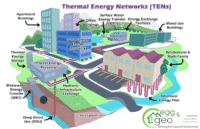
This Is Part 2/2 of Building a Sustainable Future with Thermal Energy Networks by Marc Miller, Egg Geo, LLC Modern energy demands are growing, and the need for sustainable, efficient solutions to heat and cool our homes and businesses has never been greater. Enter Thermal Energy Networks (TENs)—innovative systems that distribute and reuse energy to Read more
This Is Part 2/2 of Building a Sustainable Future with Thermal Energy Networks by Marc Miller, Egg Geo, LLC
Modern energy demands are growing, and the need for sustainable, efficient solutions to heat and cool our homes and businesses has never been greater. Enter Thermal Energy Networks (TENs)—innovative systems that distribute and reuse energy to reduce costs, cut emissions, and optimize performance.
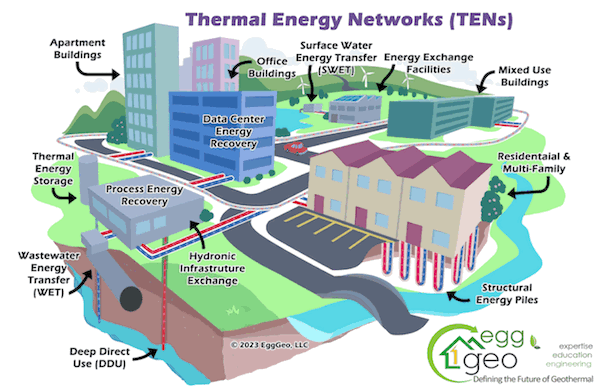
This article continues to explores the implementation of TENs, their benefits, and how one would connect their home or building to a TEN, helping you understand their potential to transform energy systems for the better.
TENs Connected to Buildings

Regardless of whether the stakeholder is a home, a light commercial building, or an industrial building, the fundamental connection to the ATL remains the same: the decoupled secondary loop. This loop features a circulator pump sized to handle the maximum load of the system. As a result, there’s no need for a balancing valve, as the flow rate (GPM) delivered to the intermediary heat exchanger is regulated by maintaining a delta T (temperature difference) across the heat exchanger.
The pump automatically adjusts to sustain this delta T, with its rated capacity based on the maximum flow required to meet the stakeholder’s demands. For instance, in heating mode, if the ATL circulating heat transfer medium is of a low temperature, compared to normal operating conditions, the secondary pump increases speed to deliver a higher rate of flow with a lower temperature fluid. Conversely if the temperature of the fluid increases, then the flow rate can be reduced.
This is because of the following formulas:
BTU/hour = Flow Rate (GPM) × ΔT (°F) × 500
Flow Rate (GPM) = BTU/hour ÷ (ΔT (°F) × 500)
ΔT = The temperature difference between the inlet and outlet water temperature of the heat exchanger
500 = a constant that accounts for the weight of water (in pounds per gallon), the specific heat of water, and a time conversion factor.
For instance, if a stakeholder requires 120,000 BTUs to be delivered to their building while maintaining a 10°F delta T across the heat exchanger inlet and outlet water temperatures, we can determine the required GPM (gallons per minute) using the following formula:
GPM = BTU / (ΔT × 500)
Now, plug in the values:
GPM = 120,000 / (10 × 500)
GPM = 120,000 / 5,000
GPM = 24
So, the GPM required is 24 gallons per minute.
Now, if the temperature in ATL drops because of thermal diversity and temperature cascade effect, the water in the ATL will contain less thermal energy. To compensate, we would need to either increase the size of the heat exchanger to provide more surface area for thermal energy transfer or increase the volume of water that has fewer BTUs to continue to deliver 120,000. Because there are fewer BTUs the delta t will decrease to 5℉-6℉. To determine the required flow rate (GPM), we use the same formula:
GPM = BTU / (ΔT x 500)
Now, plug in the values:
GPM = 120,000 / (6 x 500)
GPM = 120,000 / 3,000
GPM = 40
So, the GPM becomes 40.
In most two-pipe systems, heat exchangers are designed to operate at a specific flow rate (gpm) and a fixed temperature differential (delta T), typically around 10°F. However, one-pipe systems are can be engineered for a varying delta T’s, which necessitates the use of a larger heat exchanger for worst case scenario.
The steady-state heat transfer equation: Q = U x A x ∆T is used applied to heat exchangers to determine its thermal energy transfer capabilities.
- Q: The total heat transfer rate (measured in BTU/hr or similar units).
- U: The overall heat transfer coefficient, which measures how effectively heat is transferred through a material or system (units: BTU/hr·ft²·°F).
- A: The surface area through which heat is being transferred (measured in square feet).
- ∆T: The temperature difference between the two sides of the material or system (measured in degrees Fahrenheit).
To calculate the heat transfer rate (Q) for a plate and frame heat exchanger made of copper/nickel using the formula Q = U x A x ∆T, we can substitute the known values directly.
Here’s the example:
Given:
- A (surface area) = 24 ft²
- ∆T (temperature difference) = 10°F Between the house water loop and the ATL
- U (overall heat transfer coefficient for copper/nickel) ≈ 500 BTU/hr·ft²·°F
Q = U x A x ∆T
120,000BTU/hr = 500 x 24 x 10°F
Result:
The heat transfer rate (Q) for this copper/nickel plate and frame heat exchanger is 120,000 BTU/hr.
This equation calculates the heat transfer rate across a surface by incorporating the area, the thermal properties of the material, and the temperature difference driving the heat flow. Widely applied in engineering disciplines such as thermodynamics and HVAC system design, it serves as a foundational tool for optimizing energy systems.
In an Ambient Temperature Loop (ATL) system, as the ATL temperature drops and the delta T narrows to just 5°F or 6°F between the inlet and outlet water temperatures to meet the required BTU transfer, the pump operates efficiently without significantly increasing its speed. This approach minimizes head pressure and reduces energy consumption for pumping. The pump’s maximum speed is calibrated to manage worst-case scenarios with a 5°F–6°F delta T, ensuring consistent and energy-efficient performance under demanding conditions.
Conversely, as the ambient loop temperature rises, the delta T proportionally increases due to the higher thermal energy present in the water. In response, the pump slows down—potentially to 50% of its capacity—to adhere to the industry-standard 50/90 design principle. This ensures both energy efficiency and system reliability across varying load conditions.
The ATL system is specifically designed to align with the 50/90 guideline, a cornerstone in HVAC system efficiency. This principle prioritizes sustainable energy use by setting pumps to operate at 50% capacity under normal conditions, reducing energy consumption while maintaining peak performance. During maximum load conditions, the system scales up to 90% capacity, leveraging pump affinity laws to ensure reliable operation without over-sizing equipment. The integration of variable speed drives further enhances this strategy, enabling precise flow control and optimizing thermal energy transfer for maximum efficiency.
Additionally, the heat exchanger acts as a hydraulic separator, ensuring no physical mixing of water between different stakeholders while facilitating efficient energy exchange. This design isolates the hydraulics of each stakeholder connected to the loop, maintaining system efficiency and providing seamless, independent energy sharing.
Why TENs Are the Future
Thermal Energy Networks represent the next evolution in energy systems—offering a path to decarbonization while improving efficiency and reducing costs. Whether adopted by urban centers, industrial complexes, or residential neighborhoods, TENs can dramatically reduce energy dependencies and support long-term climate goals.
It’s not just about scaling renewable energy; it’s about harnessing it smarter. By integrating geothermal technology, heat pumps, and innovative distribution systems, TENs set a precedent for sustainable energy solutions we can all count on.
Interested in how this technology can benefit your community or business? Start exploring implementation options today to join the growing movement toward a sustainable energy future.
Part I of this story can be found here: https://mechanical-hub.com/building-a-sustainable-future-with-thermal-energy-networks/
 Marc Miller is a Mechanical Systems SME – Educator – Technical Writer – Author – Construction Management Consultant with Home – Egg Geo. He is presently the Lead Author on two textbook projects with Egg Geo. He may be reached at marcm@egggeo.com.
Marc Miller is a Mechanical Systems SME – Educator – Technical Writer – Author – Construction Management Consultant with Home – Egg Geo. He is presently the Lead Author on two textbook projects with Egg Geo. He may be reached at marcm@egggeo.com.

https://vimeo.com/1058459926 Welcome back everyone, we are in the midst of our busy traveling schedule, just returning from the WWETT Show in Indy. We’ll check in from the show with some highlights from our friends from Milwaukee Tool and General Pipe Cleaners. We’ll also visit with Dan Foley, the most recent recipient of the Carlson/Holohan Industry Read more
Welcome back everyone, we are in the midst of our busy traveling schedule, just returning from the WWETT Show in Indy. We’ll check in from the show with some highlights from our friends from Milwaukee Tool and General Pipe Cleaners. We’ll also visit with Dan Foley, the most recent recipient of the Carlson/Holohan Industry Award of Excellence.
This Weekly Update is powered by our partners at Milwaukee Tool.
Atlanta—Celebrating a century of excellence, innovation, and ingenuity, Rheem®, a leader in the water heating and HVAC/R industry, with manufacturing facilities in 88 countries, will showcase the culmination of 100 years of engineering at the 2025 AHR Expo. Rheem’s family of 50 global brands — including Rheem Heating & Cooling, Rheem Water Heating, Eemax®, Friedrich®, HTPG®, IBC™, Nordyne®, and Raypak® — will present Read more
Atlanta—Celebrating a century of excellence, innovation, and ingenuity, Rheem®, a leader in the water heating and HVAC/R industry, with manufacturing facilities in 88 countries, will showcase the culmination of 100 years of engineering at the 2025 AHR Expo. Rheem’s family of 50 global brands — including Rheem Heating & Cooling, Rheem Water Heating, Eemax®, Friedrich®, HTPG®, IBC™, Nordyne®, and Raypak® — will present a range of dependable, cutting-edge, and environmentally friendly product options designed for commercial and residential use.
